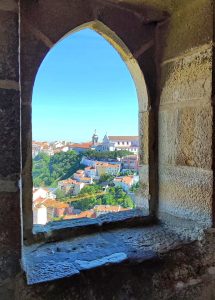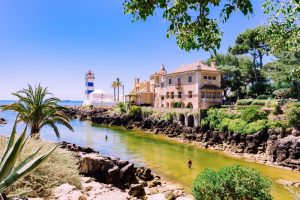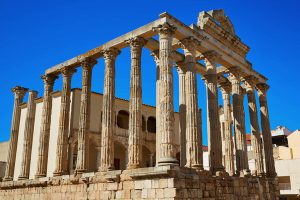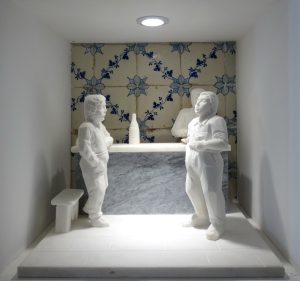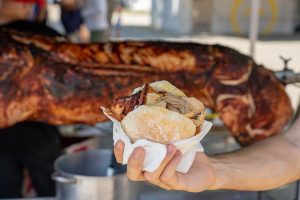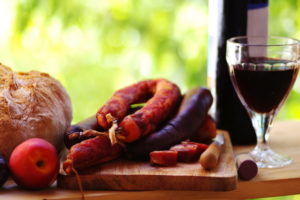
There are so many things to see and do in Lisboa and the Alto Alentejo we usually recommend at least 5/7 nights whether on a short trip combining both or as part of a broader tour around Portugal – click here for more details about our Portuquese itineraries. Here’s our guide covering all the Lisboa and Alto Alentejo highlights…
Lisboa
Birthplace to the Age of Exploration and erstwhile gateway to the world, founded on riches from Brazil and the East and remodelled after Europe’s biggest ever earthquake, Lisboa is layered with century-upon-century of history but at the same time has an ultra modern alter-ego.
Here the Manueline Mosteiro dos Jeronimos and the Pombaline elegance of the Baixa vie for space with dramatic graffiti murals of Bordalo II and company. Ancient, unspoilt tascas and bakeries from a bygone era sit comfortably beside riverside nightclubs and chic modern bars all combining to make Lisboa one of Europes most exciting cities to visit.
Wander around the tight, cobbled lanes or jump on one of the evocative trams and discover the city’s patchwork of neighbourhoods, each with its own very distinctive style – you’re sure to find one which fits perfectly!
Alto Alentejo
An enchanting land of golden wheat fields, cork oaks and vineyards stretching out to the east and south of Lisboa toward Spain and the Algarve, the Alentejo is Portugal’s largest province and, predominantly agricultural, its poorest.
The northern half, the Alto Alentejo, dotted with white-washed towns and villages and medieval fortresses, is a paradise for history-buffs, nature lovers and foodies alike, maintaining traditional ways of life which vary from one village to the next and add to the region’s gentle, authentic charm.
Table of Contents
Lisboa Highlights – 17 things to see and do in Lisboa city and around
- Lisboa
- The Lisboa Card
- 24hr Travel Pass
- The Nº 28 Vintage Tram
- Alfama
- Praça do Comercio – Europe’s largest square
- Belém
- 25th of April Bridge – Pilar 7 Bridge Experience
- Rossio
- Bairro Alto
- Chiado & Convento do Carmo
- Pretty squares
- Museums
- Markets & Shopping
- Fado
- Sintra
- Cascais
Things to See and Do in the Alto Alentejo – Out and About
- Alentejo – The Land Beyond the Tagus
- Évora
- The Marble Towns
- The Pottery Towns
- Monsaraz, Megaliths and the Alqueva Reservoir
- Dolmens and Megaliths
- Serra de São Mamede
Practicalities – Frequently asked questions about things to see and do in Lisboa and Alto Alentejo
Lisboa Highlights
Lisboa
A city of legends and mysteries

The city has certainly been host to many civilizations from the Phoenicians on, all leaving their mark. It has suffered and miraculously survived devastating earthquakes and fires, revolutions and coups and a dictatorship.
One may wonder how it is still intact, but here it is in all its glory – a city of distinctive neighbourhoods from old town Baixa and Rossio to Moorish Alfama to elegant Chiado.
With vintage trams, quirky funiculars and street lifts, hilltop miradors with spectacular views, picturesque peaceful squares, grand avenues and plazas, Roman ruins, World Heritage Belem, ornate churches around almost every corner and outstanding museums and art galleries it is this intriguing medley which makes it so magical.
Sunny street cafes, tempting cake shops, dark and exciting Fado bars, bohemian hangouts, riverside clubs, waterfront restaurants and street parties going on till dawn, there is something for everyone.
And the culinary scene is buzzing too – top quality, fresh ingredients including the best fish in the world and exotic spices, in the hands of new-generation chefs producing tastes and flavours which will tickle anyone’s palate!
And the Portuguese wine…well, like Vasco de Gama, you are on a journey of great discovery!
The Lisboa Card
The Lisboa Card is a Lisboa City Pass and a wonderful option for tourists to Lisbon. The card offers free or discounted entrance to over 80 Lisbon sights museums, and tours, including the Jeronimos Monastery, the Belem Tower and the National Pantheon.
Transport around the city is included – all trips on the Metro, public buses, the trams and the Elevadores, such as the Elevador de Santa Justa.
Outside the city, sights such as the Batalha Monstery, the national palaces of Mafra or the Convento de Cristo in Tomar are all completely free, and entrance to the Palacio Nacional de Sintra and the Natonal Palace of Queluz, is cheaper.
Excellent discounts are also available on some of Lisbon’s most important sights and purchase of the pass also entitles you to a free Lisbon guide including information on all the museums and establishments associated with this program.
It can be redeemed within 28 days of the purchase date and is validated upon its first use.
Prices start at 27€ (adults) for a 24hr pass with pro-rata reductions if you take two or three days. Buy on-line then collect at the following locations:
- AIRPORT: Arrivals, Aeroporto – Alameda das Comunidades, 1700-008, Lisboa. Daily from 7:00 a.m. to 10:00 p.m.
- TERREIRO DO PAÇO: Praça do Comércio, 1100-148, Lisboa. Daily from 10:00 a.m. to 7:00 p.m.
- CODFISH HISTORY CENTRE: Terreiro do Paço – Torreão Nascente, 1100-148, Lisboa. Daily from 10:00 a.m. to 7:00 p.m.
- CENTRO TEJO: Terreiro do Paço, 1100-016, Lisboa. Daily from 10:00 a.m. to 1:00 p.m. and 2:00 p.m. to 7:00 p.m.
- CAIS DO SODRÉ: Praça do Duque de Terceira, Cais do Sodré, 1200-161, Lisboa. Daily from 9:00 a.m to 1:00 p.m. and 2:00 p.m to 6:00 p.m.
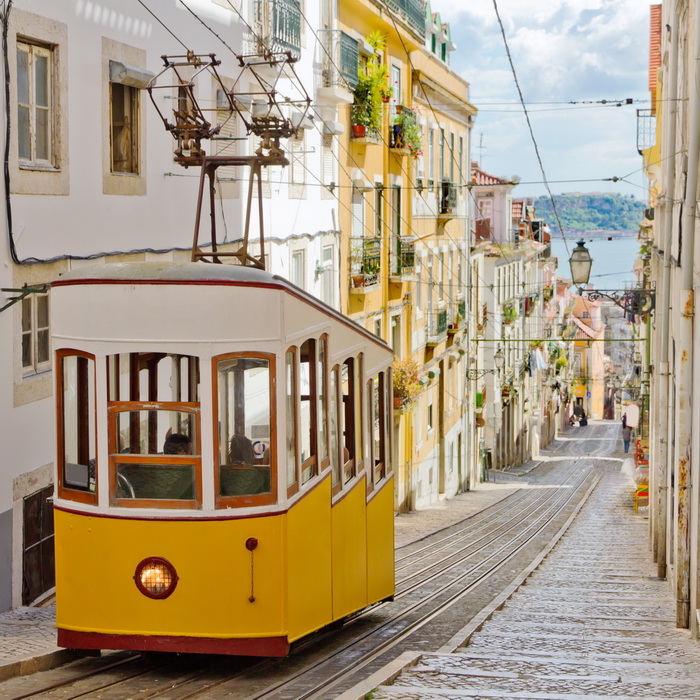
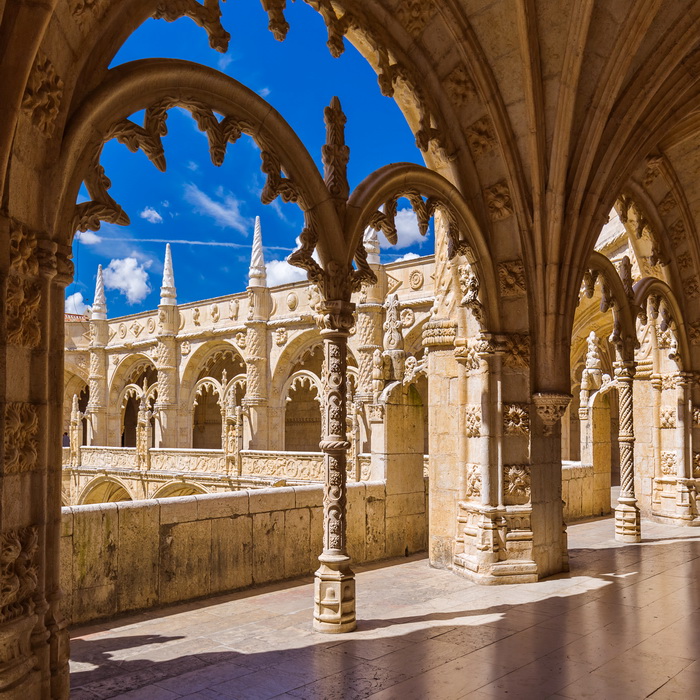
24hr Travel Pass
If you prefer to just get a travel card there is a one day travel pass available for 6.30€ at all Metro stations as well as tobacconists. This covers all metro, buses and trams in the city area (good value as a one-way trip on the 28 tram costs 2.90€!)
The Nº 28 Vintage Tram
Jump on the vintage tram 28 from Campo de Ourique or Martim Monfor a fascinating journey to C11th Castelo de Sao Jorge. Perched highabove Lisbon, explore its ramparts and take in the incredible views of the city and the Rio Tejo.
Alfama
Stroll down from Castelo de Sao Jorge through the atmospheric and picturesque, cobbled lanes of Alfama, Lisbon’s oldest and most traditional quarter – with traces of the Romans and Moors and home to seafarers and to Fado! Visit the magnificent C12th Sé (cathedral) the churches of Sao Antonio and Sao Vicente de Fora and the Museu do Fado then head downhill and try out one of the traditional ‘tascas’ – small, traditional bars offering simple food and, of course, Fado.
Praça do Comercio – Europe’s largest square
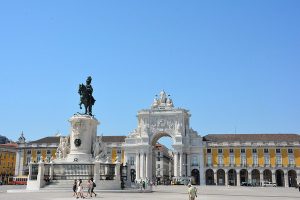
Belém
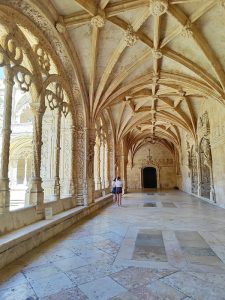
Sample Lisbon’s famous custard tarts “pasteis de nata” and if time permits take in the Museu Coleccao Berado for contemporary art at its best and Museo Nacional dos Coches with Cinderella like coaches!
Join a sunset cruise to admire the city sights.
25th of April Bridge – Pilar 7 Bridge Experience
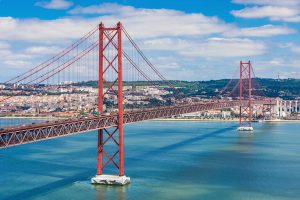
The visit gives an interesting insight into the construction (in which many workers died) and there’s a viewing platform at the top with stunning views of the city, the river, and of course, the bridge.
Rossio
Enjoy the buzz at one of the cafes on the Pracas de Dom Pedro IV and Figueira in the Rossio district and don’t miss the amazing neoManueline Rossio train station or Lisbon’s oldest cake shop “Confeitaria Nacional”.
Bairro Alto
Take the vintage Elevador da Gloria, from Praca dos Restauradores up to party loving, bohemian Bairro Alto. It retains a distinct local character, balancing modern trends with traditional Portuguese culture, making it a must-visit for those seeking an authentic and vibrant experience of Lisbon. Quiet in the day, but oh so alive at night!
Chiado & Convento do Carmo
Wander round the elegant Chiado district with its old world cafes and trendy boutiques and designer shops blending in with the historical sights of Convento do Carmo and Igreja Sao Roque and their fantastic museums. Get a great view of Castelo Sao Jorge from here from the Mirador Pedro de Alcantara.
Pretty squares
Escape the crowds at Lisbon’s greenest and most peaceful squares – Praca do Principe, Praca das Flores, Praca da Alegria…
Museums
Get your fix of art and more at the amazing museums Museu Calouste Gulbenkien, Centro de Arte Moderna , Museu Nacional de Arte Antiga and Museu Nacional do Azulejo.
Markets & Shopping
Go shopping in elegant Avenida da Liberdade or bustling Baixa. Take in the most popular and authentic flea market “Feira da Ladra” in Alfama. (Tuesdays and Saturdays).
Fado
Treat yourself to an evening of Fado at Sr. Vinho in the Lapa district, a club owned by Fado star, Maria da Fe. First rate performers. For a very special, but not expensive meal, dine first at nearby Clube de Journalistas.
Sintra
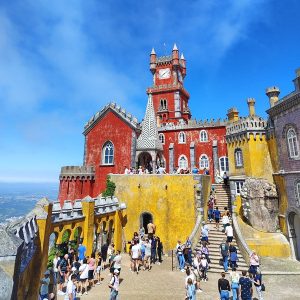
Cascais
Bus or train it to Cascais, one time a fishing port, now a popular resort, but still with charm with small museums, pretty gardens and plenty of fish restaurants.
Things to See and Do in the Alto Alentejo
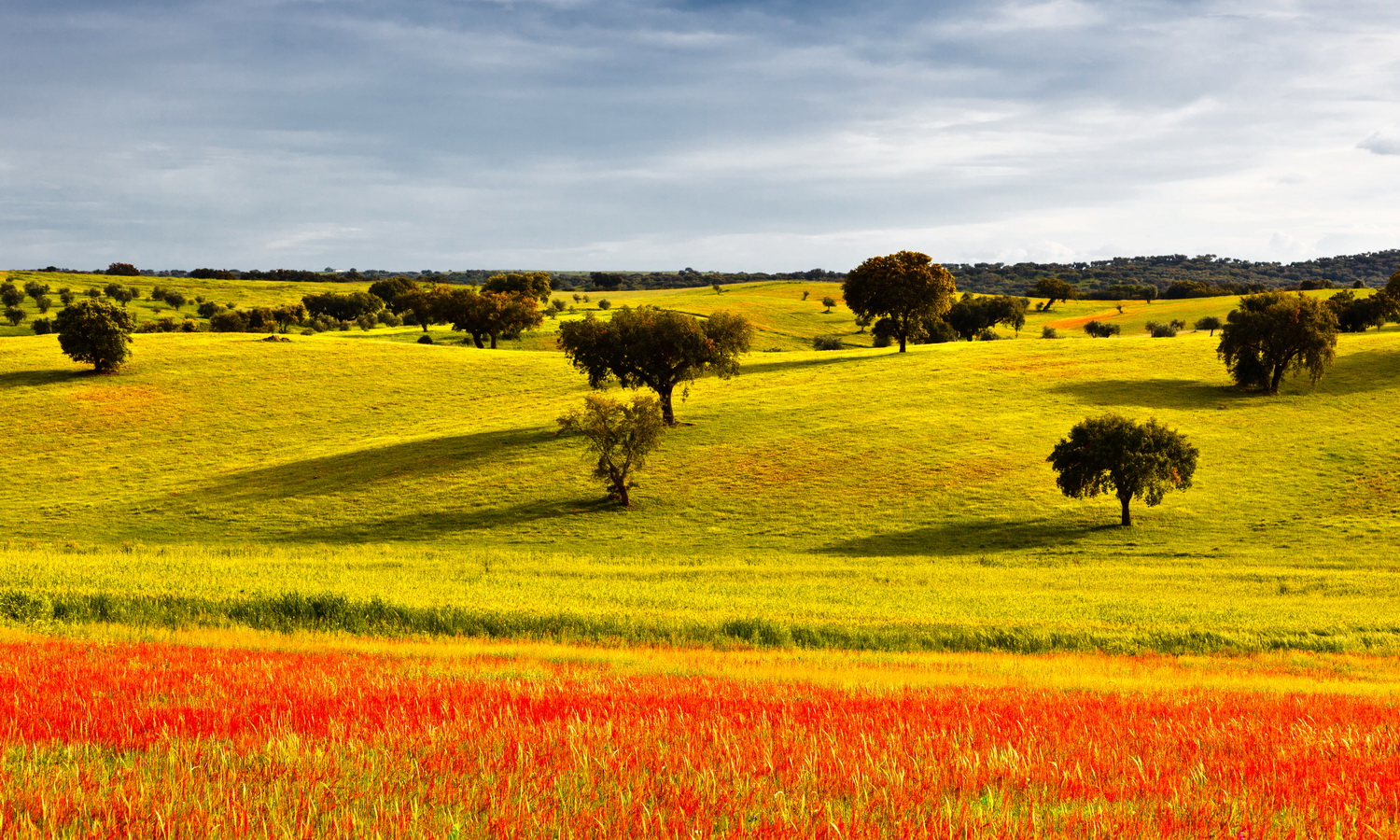
Alentejo – The Land Beyond the Tagus
The Alentejo, from the Roman “the land beyond the Tagus”, Portugal’s largest and even now poorest and least populated region, lies south of Lisboa and north of the Algarve, bordered by Spain to the east and washed by the Atlantic ocean to the west. It is divided into two regions – the Alto and the Baixo, with Evora capital of the former and Beja of the latter.
Known as the “terra do pao” – the land of bread, it also produces half of the country’s wines. Its landscape of golden wheat fields, gently rolling hills, vineyards, cork forests and olive groves, criss-crossed with small rivers and dams, is captivating. Add traditional whitewashed villages, marble towns, walled fortress towns, cliff- top castles, medieval cities and a stunning rugged coastline, and you will begin to get the picture.
Steeped in history, with the Romans, Visigoths and Moors leaving their firm marks, the area is covered in megaliths and dolmens, evidence of a busy prehistoric period.
Farming, using traditional methods, though modernity is creeping in, is still the mainstay and traditional handicrafts from pottery to hand woven rugs still very important. Hunting is not just a popular pastime, but a means of living and singing and dancing part of everyday life. The flora and fauna will bring pleasant surprises from rare plants and an amazing array of wild herbs to the busy bird life.
And all across the region you will find traditional cuisine at its best – pork, game, fruit and vegetables, bread, cheese and wine and fantastically fresh fish and seafood on the coast.
More importantly, perhaps, is the warm welcome you will receive from its proud, if somewhat melancholic people, who throughout the centuries have learnt to bear suffering with a smile!
Évora
Conquered by the Romans in 59BC and of great importance in Roman Lusitania (witness to which the fine second century temple that stands to this day), and subsequently occupied by Visigoths and Moors, who gave the town its street layout and defensive walls, it´s easy to see why Évora enjoys the status of World Heritage Site.
In medieval times, following the Reconquista from the Moors in 1166, an elaborate cathedral with delightful cloisters and several palaces were added. Then, in the 15 Century, the city enjoyed a Golden Age when the Portuguese Kings established their residence there to escape plague-ridden Lisboa, at which time the University, Portugal’s second oldest, was established as well as the attractive main square which forms the town’s social hub to this day.
Today Évora continues to be a lively University city with a strong cultural – and gastronomic – scene whilst preserving fascinating vestiges of all its previous inhabitants and cultures. Its unique character lies in its whitewashed houses, the indoor tiled decorations and the wroughtiron balconies, all typical of the 16th to 18th centuries, which had a decisive influence on colonial architecture in Brazil.
Set above the Alentejo plain (hence its strategic importance), Évora is a superb base to explore all the treasures the region has to offer. Neolithic monuments (see separate section below ‘Dolmens and Megaliths’) and small family-run wineries are just nearby. The potteries of Redondo a little further and a day trip to Marvão, Elvás and the other fortress towns in the mountains near the border with Spain are also quite feasible. And, after a day’s exploring, what better than to sit with the locals in the square or recharge your batteries in one of the city’s many excellent restaurants.
If you’re interested in the regional wines of the Alentejo (and you should be!) don’t miss the tasting room of the Rota dos Vinhos do Alentejo (see the section on ‘Wine Routes’ below). Also Bodegas Erdiveira, one of the best local wineries, have a shop in the old town (see also Monsaraz). Some of the wines are available at the airport so it’s a good chance to try-beforeyou-buy.
Don’t leave the city without visiting the famous Bone Chapel (Capela dos Ossos, in the San Francisco church) constructed from the skeletons of an estimated 5000 monks, with the chilling inscription “We bones that here are, for yours await” over the door…
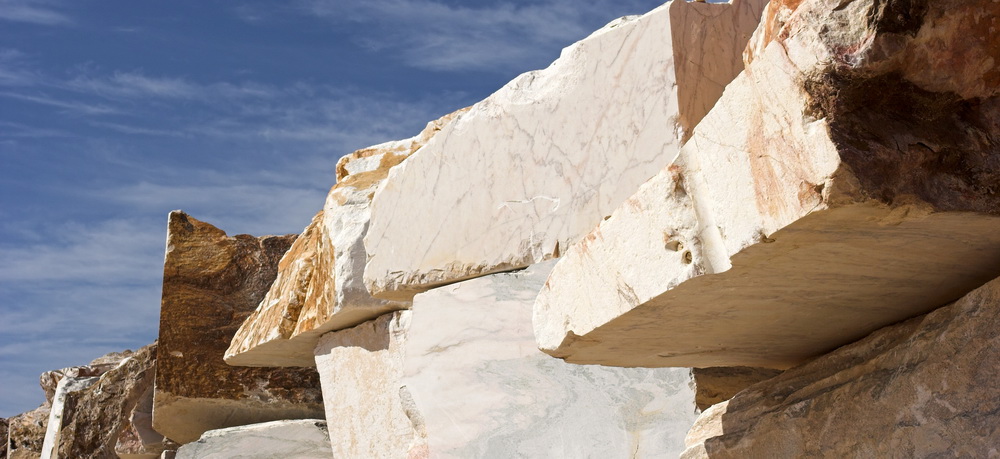
The Marble Towns
As you drive through the beautiful, gently rolling countryside of olive groves, cork forests and vineyards on your approach to the delightful towns of Estremoz, Borba and Vila Vicosa, giant mountains of rubble or what looks like rubble suddenly appear before your eyes. Take a closer look and you will see that all around is marble and miles and miles of it. Take a stroll around the towns themselves and you’ll find it all over the place, from the cobblestones and doorsteps to the magnificent palaces and churches. It is even used to make the paint that gleams from the whitewashed buildings!
Estremoz
With its imposing C13th hilltop castle, a gleaming white Royal Palace (now a Pousada), zig-zagging ramparts, gracious squares and pretty lanes lined with orange trees, Estremoz, once the seat of C14th King Dom Dinis, has a feeling of grandeur. Set in the heart of marble country, marble shines out from every corner! Yet, at heart, it is a simple, provincial town and busy trading centre, with plenty of traditional arts and crafts. Its buzzing, atmospheric Saturday market, held in the main square, should not be missed. A great opportunity to buy anything from earthenware pots and figurines to good old fashioned gardening tools and regional gourmet delights!
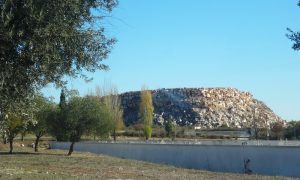
In the upper town, the Museu Municipal, housed in a beautiful C17th almshouse, has an incredible display of unique Estremoz pottery figurines, now classified as intangible World Heritage, covering 200 years And the inner man is certainly not forgotten in Estremoz. There are some excellent restaurants from traditional “adegas” to romantic, more upmarket establishments, all serving delicious, locally sourced food. If your timing is right, the town’s culinary festival “Cozinha de Ganhoes” is held at the end of November.
Borba
Just a short drive from Estremoz, the lovely little, peaceful town of Borba, is famous for its great red wines which can be sampled and bought at Adega Cooperativa de Borba. The simplicity of the town and the friendly feeling it exudes is endearing in itself. Before you start to wander around, it is well worth going into the beautifully presented and very informative tourist office in Praca da Republica.
Marble there is and plenty of it, but there are not many signs of obvious wealth here, though there are some fine C18th mansions and several interesting churches, including the baroque chapel of “Senhor Jesus Dos Aflitos” with its chessboard façade and the four chapels of the stations of the Cross. The shining whiteness of the Fonte de Bicas (Bicas Fountain), built in 1781 for the visiting King Dom Pedro III, will immediately catch your eye.
Aside from monuments, there are a surprising number of cabinetmakers and fascinating antique shops and perhaps more importantly an exquisite local cuisine, rich in aromatic herbs. Borba’s superb olive oil, cured sausages and unique sheep’s cheese form part of this as does the Doce Dourado de Borba, an almond and cinnamon sweetmeat.
Luckily the town has a wonderful selection of welcoming, family run restaurants, each one known for their house speciality!
Vila Viçosa
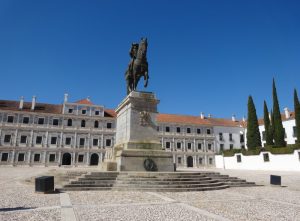
The first sight of the stunning C16th marble palace “ Paco Ducal” from the gigantic palace square, is a knock out. Once home to the Bragança dynasty who ruled Portugal until it became a republic, Catarina de Bragança was born here and lived here until she married Charles 11 and became Queen of England. On the other side of town, at the far end of the attractive Plaza da Republica, lined with orange trees, is the fascinating C14th castle where the Braganças lived before their palace was built.
A visit to the museum, which forms part of the castle, and has an extraordinary archaeological collection, spanning from the Palaeolithic to the Roman, should not be missed. Nor should the beautifully tiled C15th century church within its walls – home to Portugal’s patron saint “Nossa Senhora Da Conceicao”. Once she was “sworn in”, the kings of Portugal never wore the crown again. Now, that is progress for you!
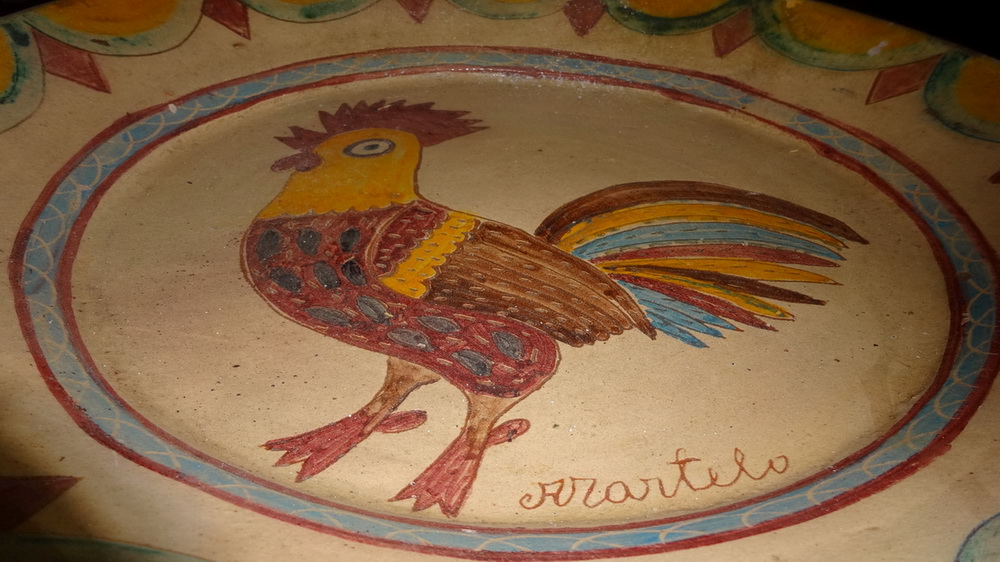
The Pottery Towns
Sao Pedro Do Corval
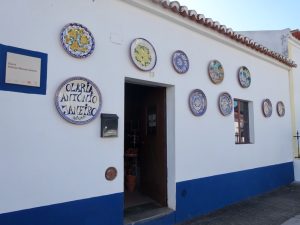
Hard to know how to pick your “olaria”, but one we know is “Olaria Luis Janeiro” where they are most welcoming and helpful.
Redondo

Also, worth calling in at the wine museum / tourist office “Museu do Vinho” (in the centre of town, across the way from the Town Hall) where Ernesto will give you a good insight into Alentejan wines and give you all sorts of useful tips on wine routes and what to visit in the surrounding area.
Elvás
Right on the Spanish border, on the line-of-least-resistance between Madrid and Lisboa, Elvás occupies a strategic site of the very highest importance and is the biggest of the string of fortress towns which occupy the mountain passes all along the border.
The World Heritage Site, extensively fortified in the Dutch style, from the 17th to 19th centuries, starting when Portugal regained independence in 1640, represents the largest bulwarked dry-ditch system in the world coupled to the 6km long Amoreira aqueduct, built to enable the stronghold to withstand lengthy sieges – and indeed, the Spanish never did manage to take it.
In addition to the barracks and other military buildings the old town contains a good handful of churches and monasteries as well as remains dating back to the 10th century AD and is especially atmospheric to walk around by night.
The two outlying forts were added in the 18th century, on vantage points north and south of the main town, once canon fire became the predominant artillery and the hills were suddenly seen to be dangerously close. Particularly interesting is the Graça Fort which was built during peacetime and hence exactly to plan – a true marvel of military engineering.
Elvás makes a great setting-off point for forays into Spanish Extremadura. Badajoz is just 8km away, Roman Mérida an hour’s drive and an excursion taking in Cáceres or Trujillo is quite feasible if you fancy a Spanish day out.
No visit to Élvás would be complete without a visit to the Hotel Santa Lucia. Portugal’s first Pousada (though no longer part of that group) and host to a famous meeting of Franco and Salazar. The landmark restaurant is very elegant yet reasonably priced and claims the fame of having invented the dish Bacalhau Dorada, a Portuguese classic.

Monsaraz, Megaliths and the Alqueva Reservoir
The ancient, walled, hilltop village of Monsaraz with its Dom Dinis castle and spectacular views over the Alqueva reservoir and the surrounding countryside, though touristy, still has a feel of old Portugal. The Moors were here, the Christians as well and the Knights Templar too. Walk through one of its four arched entrances and stroll the cobbled streets, visiting its two churches and the Museu de Arte Sacra with a wonderful C14th century secular fresco, depicting a two-faced good-and-bad judge. For a week in July there is a biennial music festival “Museu Aberto” when the whole village comes alive!
Bodegas Erdiveira, one of the best local wineries, have a shop in the old town (see also Évora). Some of the wines are available at the airport so it’s a good chance to try-before you-In the area around Monsaraz are numerous Neolithic megaliths, the most spectacular being Cromoleque de Xerez with a huge menhir at its centre and Menhir de Bulhoa.
Alqueva Reservoir
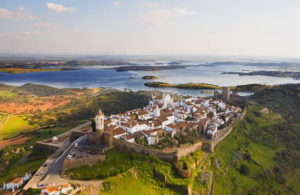
The reservoir is also a popular destination for recreational activities including boating, fishing, and birdwatching, thanks to its scenic surroundings and rich biodiversity. Its stunning landscape, dotted with charming villages and historic sites, makes it a notable attraction in the region.
Several trips are available on a Dutch sail boat through. Bike and canoe hire are other options. www.sem fim.com – 00351 961 667 584
Reguengos de Monsaraz
At one time with a busy textile industry, producing hand woven woollen rugs “mantas alentejanas” (there is still one producer left, in Rua Mendes, off the road to Monsaraz), Reguengos is now well known for its wineries in and around the town. The local tourist office can point you in the right direction of the best.
The most acclaimed winery is Herdade do Esporao , seven kilometres south of the town. With vestiges from Roman times, it produces a wide variety of wines and has a highly recommended gourmet restaurant with superb vineyard views. Tours of the vineyards and the cellars are available.
Evoramonte
A small, simple village between Evora and Estremoz, but worth a stop. It was here that the convention ending Portugal’s civil war was signed on 26th May 1834 and there is a commemorative plaque on the house where it took place. Perched high up above the village is the interesting C16th castle, originally built in 1306, but rebuilt after an earthquake in 1531. From here you have the most spectacular panoramic views of the surrounding area.
Arraiolos – The Carpet Town
Twenty kilometres north of Evora, the small town of Arraiolos, dating back to the 2nd or 3rd century BC, has been making handwoven carpets “tapetes” since the C12th century. With a marked influence from Persian rugs, the patterns used are based on abstract motifs, “azulejo” – tile designs or just simply, flower, bird or animal depictions. Plenty of shops to choose from if you are tempted into buying one to take home.
It is worth a wander around the little town too to take a look at its old dye chambers in the main square and the beautiful interior of the church with its golden altar and C18th azulejos.
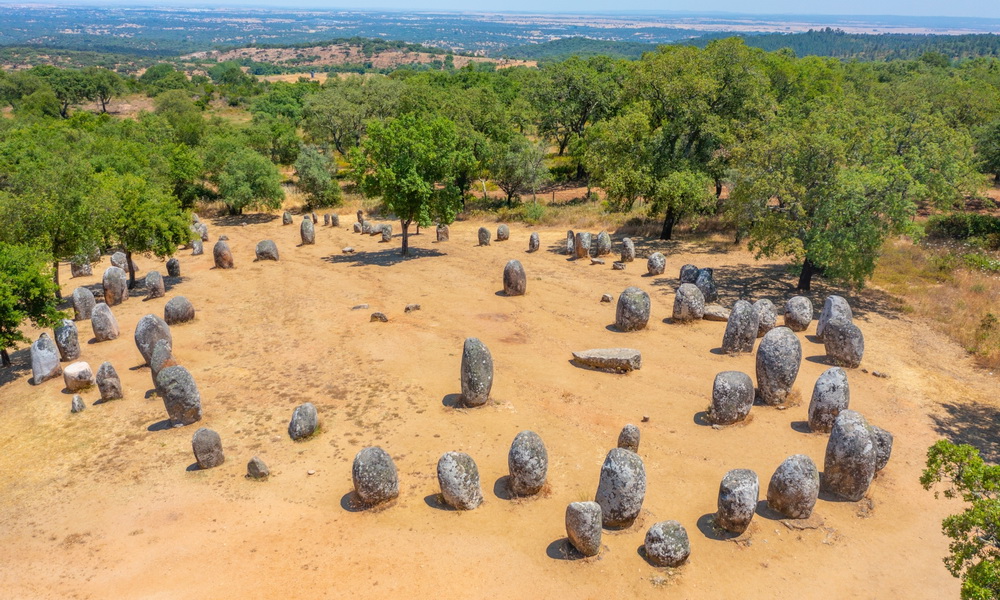
Dolmens and Megaliths
These prehistoric structures, built around 5000 – 7500 years ago abound in the Alentejo, many near the city of Evora. The most dramatic and outstanding are:
Cromeleque dos Almendres
The most important megalithic group in the Iberian Peninsula, a huge spectacular oval of standing stones, erected over different periods, in the most beautiful setting of olive groves and cork trees, can be found 15 kms west of Evora, not far from the village of Guadalupe.
Anta Grande do Zambujeiro
Thirteen kilometres southwest of Evora, near the town of Valverde, is Europe’s largest dolmen, The Great Dolmen of Zambujeiro with seven stones, six metres high and a closing slab. It is protected by a huge metal sheet which rather spoils the total impression.
For a guided visit Evora Megalitica are a group of friendly, young English-speaking archaeologists based in Évora. www.eboramegalithica.com – 00351 964 808 337
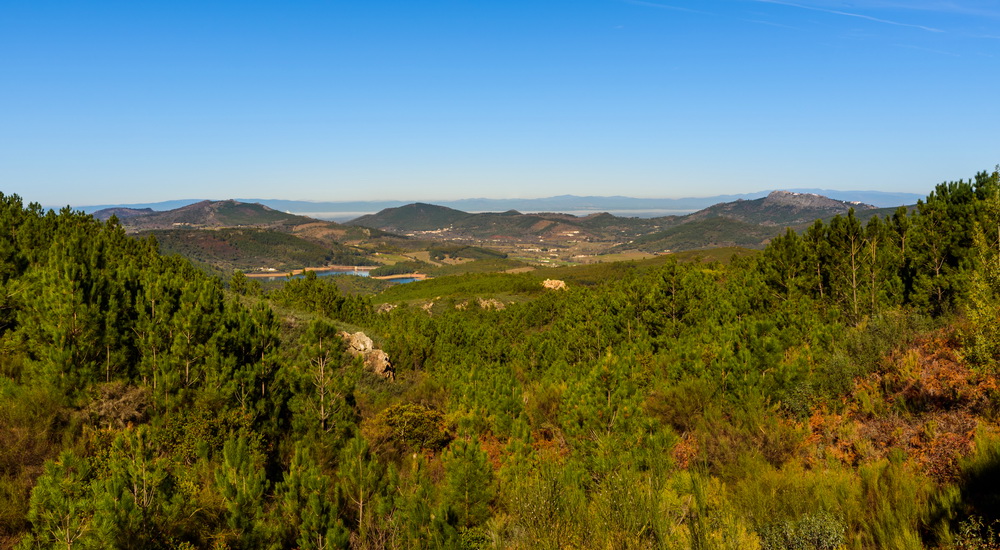
Serra de São Mamede
Portalegre – The Tapestry Town
High on a hilltop, built on an ancient ruined settlement called Amaya, at the foot of the lush Serra de Sao Mamede, Portalegre, the capital of Alto Alentejo, is perhaps best known for its tapestry industry, which had its heyday in C16th. The faded, grand Baroque mansions within the city walls and the Portalegre Tapestry Factory and the excellent Museu de Tapecaria de Portalegre Guy Fino are evidence to this. The factory still produces amazing tapestries of works of famous modern artists and the museum is a showcase for these.
Marvão
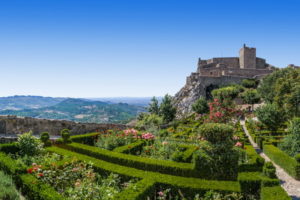
Stroll around the pretty whitewashed village, visit its formidable C13th castle and walk round the walls to get the full impression of the place. If time permits, there is an excellent Roman museum in nearby Sao Salvador de Aramenha . Follow signs from there to Ammaia, which was the name of the huge Roman city once there.
Castelo de Vide
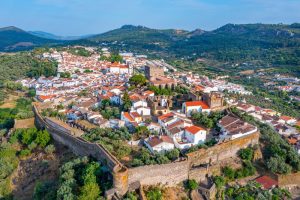
With the best preserved stone Gothic doorways in Portugal and the oldest synagogue dating from C13th, now forming part of the museum which houses a fascinating collection of items illustrating the history of the town’s Jewish community, the true pleasure lies in just wandering around, getting to know its friendly people and soaking in the atmosphere.
Eat and Drink in Lisboa and the Alto Alentejo
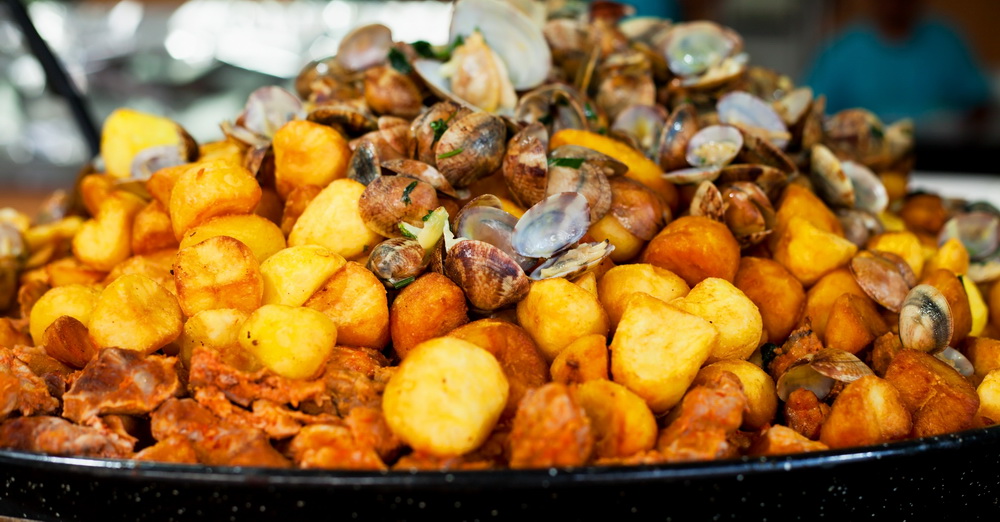
Lisboa
Over the last seven years as Lisboa has gradually become one of the hottest tourist destinations in Europe, its culinary scene has also moved with the times at a great pace. Top chefs such as Jose Avillez, Joao Rodrigues, Ljubomir Stanisic, Henrique Sa Pessoa and Susanna Felicidade with their fantastic restaurants, have transformed the gastronomy, innovating and recreating national and international cuisine.
Exciting and applaudable as this is, to get a true taste of Lisboa, one mustn’t forget its rustic tascas (small and simple, family run restaurants) found in all corners of the city, serving down to earth, traditional food with handwritten menus at very affordable prices. Lisboa’s favourite sandwiches “prego” (beef steak sandwich) and “bifana” (pork steak sandwich) are invariably on offer too. Used daily by the majority of Lisboetas from all walks of life, this is where you will get a real insight into authentic Portuguese cuisine and customs.
For a drink and a tasty snack, the ornate kiosks in the parks, are an ideal choice to soak in the local atmosphere and if you fancy a taste of something more exotic, immigrant communities have opened little restaurants serving food from Goa to Cape Verde to Brazil and there are even clandestine Chinese restaurants to seek out!
To get your full dose of sugar, Lisboa will not disappoint either. There are superb “pastelerias” (cake shops) everywhere, selling cakes and pastries, many made from ancient recipes from convents and monasteries. You can’t leave the city without trying the iconic “pastel de nata” (custard tart) or “pastel de Belem” (also a custard tart, but a safely guarded recipe), but there are many more from “toucinho do Ceu” (literally ‘bacon from heaven’) to “travesseiro de Sintra” (Sintra’s pillows)! The choice is yours.
Alto Alentejo
The Alentejo, “ the land beyond the Tagus”, the land between Lisboa and the Algarve, the land of vineyards, olives groves, oak and cork forests, fertile farmlands and a dramatic coastline, covering one third of the entire country, not only is a cultural eye opener, but also a still almost undiscovered gastronomic delight.
For many years, despite its natural sources, it was the poorest part of Portugal, with food very hard to come by, but the proud people created a simple, traditional, yet imaginative cuisine, using local, seasonal ingredients to their best to produce delicious, satisfying dishes. Age old recipes, freshness and quality of produce is what Alentejan cooking is really all about.
Based on pork, lamb, salt cod and bread – always bread (how varied and excellent it is!) with local wild herbs – coriander, mint, oregano and other aromatic herbs, garlic , onion and fruity olive oil, it all adds up to a cuisine with a deep connection to the soil – refreshingly unpretentious and totally in keeping with its landscape.
You will find the most delectable olives, tasty little round sheep and goats’ cheeses from Serpa and Evora, sweet cured ham “presunto”, wild mushrooms, asparagus, sweet potatoes and a great variety of other vegetables – a visit to a local market will spread these all before your eyes. The black pork “porco preto” (pigs raised on acorns in oak forests) literally melts in your mouth! Scrummy rabbit, hare and other game dishes feature on many menus too as do the “acordas” – hearty bread soups with fresh coriander and garlic, sometimes with a bit of fish too.
Specialities to try are “ensopado de borrego” – lamb stew, “sopa de cacao” – dogfish soup, “sopa de beldroegas” – purslane soup, “cozido a la Portuguesa a modo de Alentejo” – Portuguese stew Alentejo style and the well known surf n turf dish “ carne de porco a la Alentejana” – black pork with clams.
Hit the coastline and you will feast on superb fish and seafood, just plainly grilled or in forms of stews and rice dishes.
As in all of Portugal, the sweet tooth is by no means forgotten. All sorts of tempting pastries and cakes, many still made by nuns, are available in the pastelerias and cafes and the top regional dessert “sericaia” – a baked egg custard with the most divine sugar plums from Elvas is not to be missed.
In the Alentejo, not only will the food pleasantly surprise you, but also its wines, some of which are exceptional. The region, producing half of the country’s wine, has eight demarcated wine regions – Borba, Evora, Redondo and Reguengos being the best known. The reds are bold and full bodied, the whites, smooth and well balanced. In many restaurants, apart from the carta de vinhos (wine list) there will be a house wine served in a jug which from our experience is much more than just drinkable and also excellent value.
So, be it in a typical, authentic, family run restaurant, of which the Alentejo can boast so many, or in a more upmarket establishment, be prepared for a wonderful experience of “real” food and wine.
Wine Routes – “Rotas dos Vinhos do Alentejo”
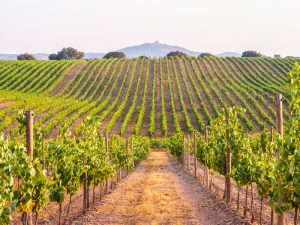
Distinct soils and selected grape varieties provide a diversity of choice, but generally the reds are intense, full bodied and smooth and the whites, aromatic, fresh and balanced. Each winery, known as adegas, quintas or herdades naturally have their own special selection.
There are three main wine routes in the region – the Sao Mamede route, the Historic route and the Guadiana route. Well advised, is a visit first to the Tasting room of the Alentejo Wine Route (Rota dos Vinhos do Alentejo) in Evora where you can taste some of the wines and be given suggestions by the helpful staff of the best routes to take and the wineries to visit – and perhaps start to understand this highly-complex and fascinating wine region.
On a smaller scale, the wine museum “Museo do Vinho” in Redondo is also a good introduction and very informative. And if you happen to be in the area in late summer you could do no better than to join in on one of the grape harvesting festivals. The one in Borba, “Festa da Vinha e do Vinho” will give you a great insight.
Frequently Asked Questions about Things to See and Do in Lisboa and the Alto Alentejo
How to get to Lisboa and Alto Alentejo?
Fly directly to Lisboa / Lisbon and hire a car – the best options are:
From London Gatwick: Easyjet or TAP Portugal
From London Stansted: Ryanair
From London Heathrow: British Airways or TAP Portugal
From Luton: Easyjet
From Edinburgh: Easyjet or Ryanair
From Manchester: Ryanair, Easyjet or TAP Portugal
From Bristol: Easyjet
From Dublin: Ryanair, TAP or Aer Lingus
PLEASE NOTE some flights are seasonal.
NB: Flights are not included
Alternatively you could fly to Porto (3hrs). Alternatively, Faro (2hrs 30mins) in the Algarve region is a good entry point for tours in the Alentejo. Ask us about these.
When to go to Lisboa and Alto Alentejo?
As you head south from Central Portugal to Lisboa, the climate gets progressively warmer so a visit to Lisboa and Alto Alentejo is best enjoyed in the Spring or the Autumn; from mid-March through to early July then from September through to mid-November when it enjoys a relatively gentle climate which supports the production of the excellent Alentejo wines.
The Atlantic breezes refresh Lisboa and the nearby coastal lands, extending its benefits to the further inland Northern part of the Alentejo. Subsequently, the sweltering temperatures of the far south during the summer are milder here.
Winters are a bit rainy and temperatures tend to lower during the night, but at the height of summer temperatures can often reach the 30s Centigrade – so best avoided if you are not a sun lover ( with air-conditioning and a siesta it can be made possible, and it is all at its quietest).
How long to stay in Lisboa and Alto Alentejo?
There is a lot to see and do in the region so we normally recommend at least two nights in both Lisboa and the Alto Alentejo. Taking into account the grandour of the Portuguese capital, it would be ideal to extend your stay in the city to three or more nights (if you have time, of course) and discover its countless highlights – some of them above mentioned.
We have several tours combining Lisboa and the Alto Alentejo including some other interesting regions of the country so that you can take advantage of your time and explore the contrasts of this beautiful land.
What to eat in Lisboa and Alto Alentejo?
And how could such a prestigious wine region be without its gastronomy?
As mentioned above (check Eat and Drink section), the cousine of Lisboa and Alto Alentejo is based on tradition using local quality ingredients all washed down with the fantastic Alentejan wines.
In multicultural Lisboa, the presence of top chefs has marked a difference transforming its gastronomy into a more innovative space. Though the real taste of the city is still very alive, in the tascas and the street food. Don´t miss Lisboa’s favourite sandwiches “prego” (beef steak sandwich) or “bifana” (pork steak sandwich) as you rush it to the next interesting museum or nice square.
Hearty regional dishes abound in Alto Alentejo. Based on pork, lamb, salt cod, bread and local wild herbs, its cousine will definitely surprise you. “Ensopado de borrego” – lamb stew, “sopa de cacao” – dogfish soup, “sopa de beldroegas” – purslane soup, “cozido a la Portuguesa a modo de Alentejo” – Portuguese stew Alentejo style to the well known surf n turf dish “ carne de porco a la Alentejana” – black pork with clams, try any of these and you will sart to understand the soul of the Alentejo and its people.
All the better, the sweet tooth is by no means forgotten. You will find tempting pastries and cakes wherever you go. And be assured of excellent red and white wines from the Alentejo to accompany your meals. Bom apetite!
What to buy in Lisboa and Alto Alentejo?
In Lisboa and the Alto Alentejo, like in any travel destination, you will find all kind of typical souvenirs as well as authentic pressies in the many shops spread all over the region. From small family-run businesses to long-established markets, there is a lot to choose from!
Alentejo produces half of Portugal´s wines, some of which are exceptional so don´t miss the opportunity and grab a bottle (or two) – more info in our Eat and Drink section. If you are more into liqueurs, then go for a good bottle of Ginjinha (a cherry liqueurs obtained from the maceration of cherries in brandy), but only after trying it at one of the many shops specialised in this traditional digestif for generations.
Olive oil is certainly another delicacy you may want to bring home. Spanish oil is probably the most famous, but Portugal also has a long tradition in the production of the liquid gold. Whilst visiting the vast olive groves of the Alentejo is the best moment to get your treat, but you can find it anywhere you go.
Cork-based products should be on your wish list too. Being Portugal, and especially the Alentejo region, the main cork producer in the world, there are several handcraft worshops producing and wide variety of accessories. Bags, purses, wallets, belts or even hats, they are both unique and sustainable.
No need to mention that you won´t have a better opportunity to buy, first-hand from the artisan!, a colourful ware at one of the many olarias (pottery workshops) than during your visit to the “pottery towns” of the Altenejo.
And last but not least, tiles replicas, embroidered linens, local cheeses and sausages, chocolate and pastries or even fado music CDs are a safe bet for the loved ones!



